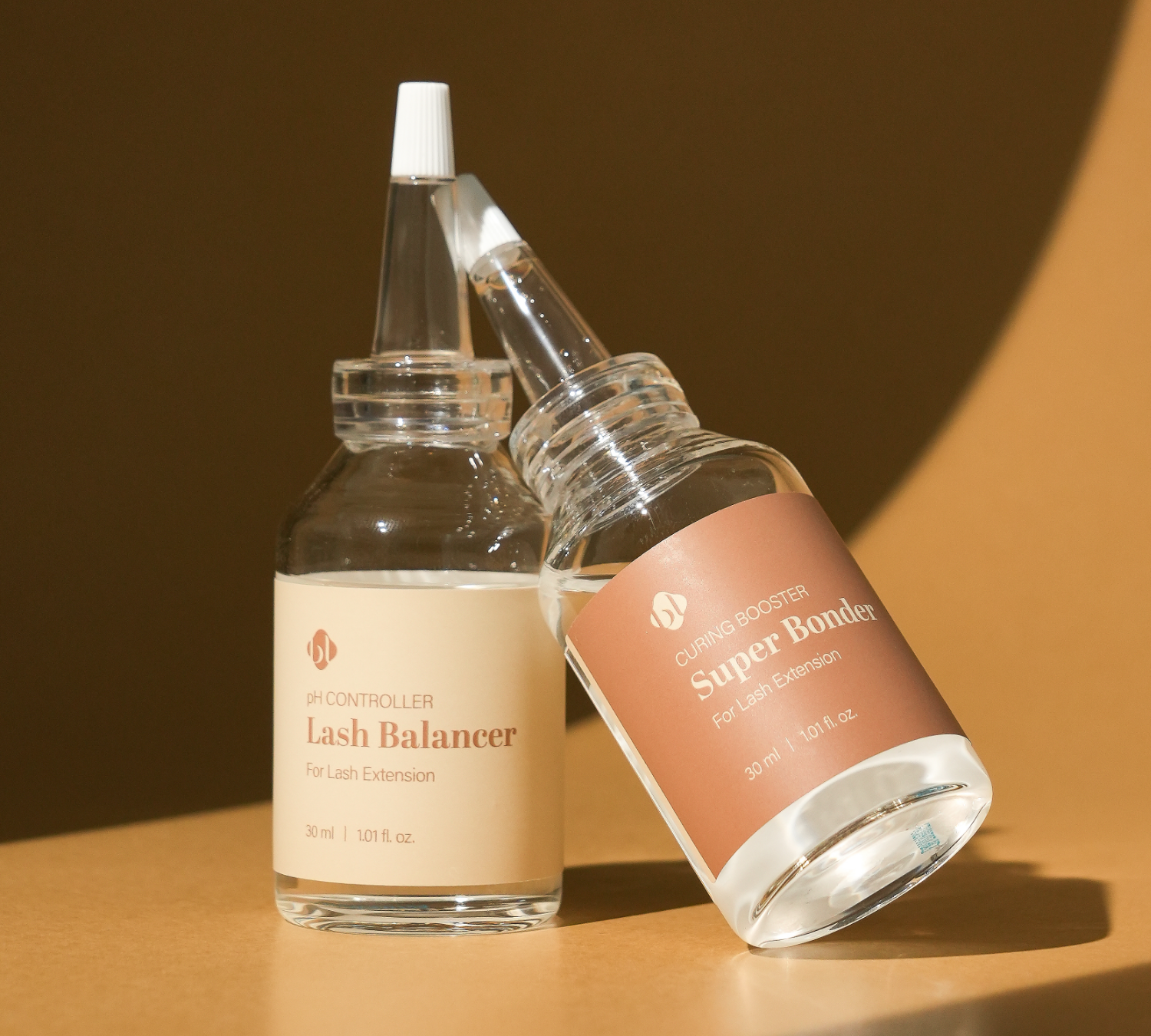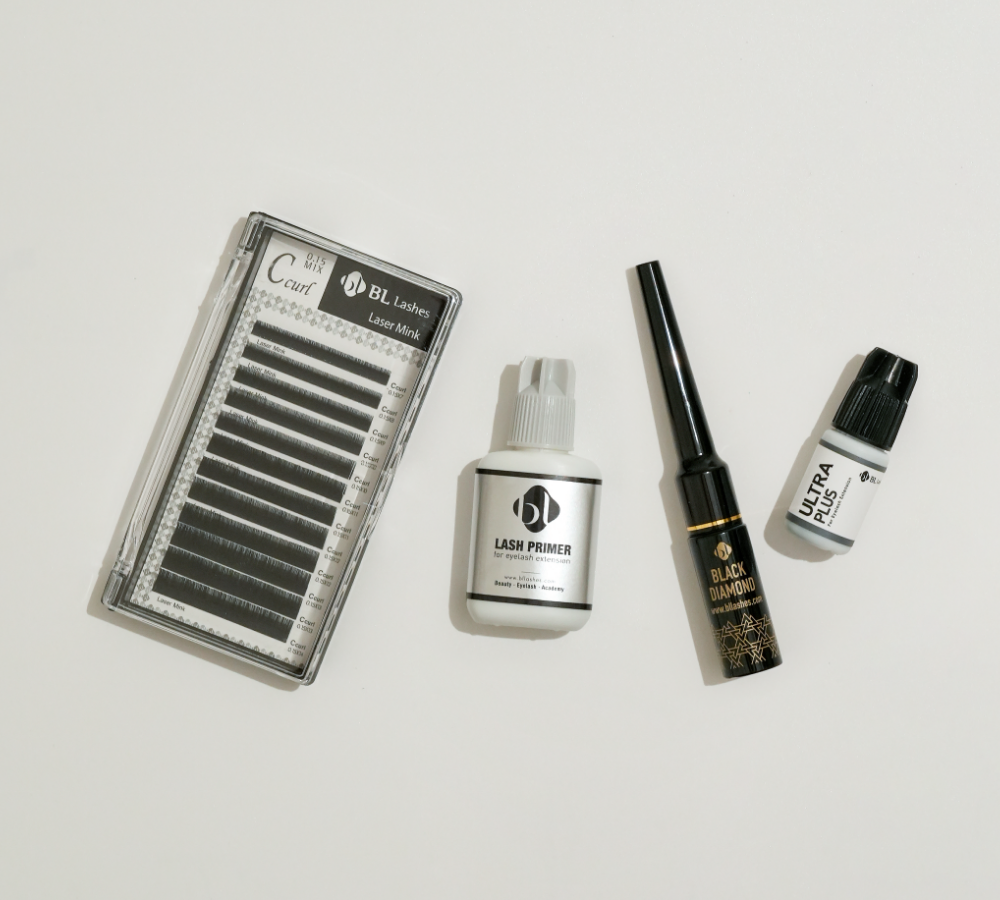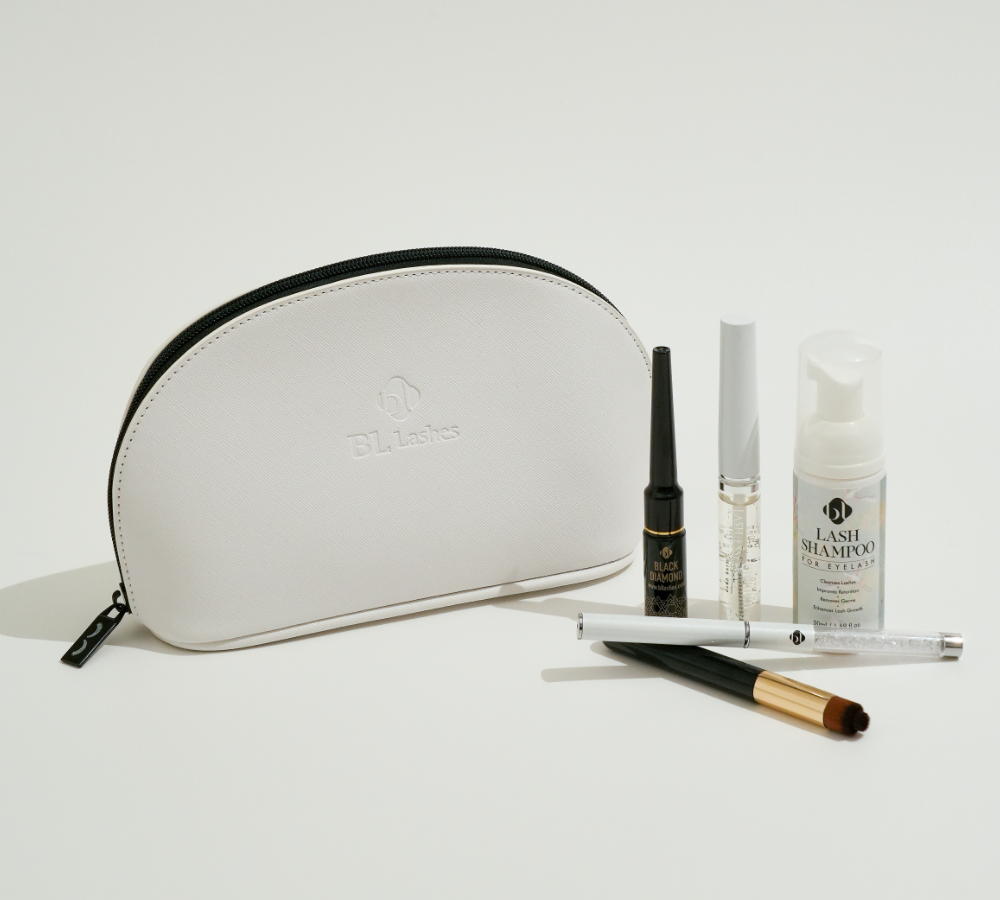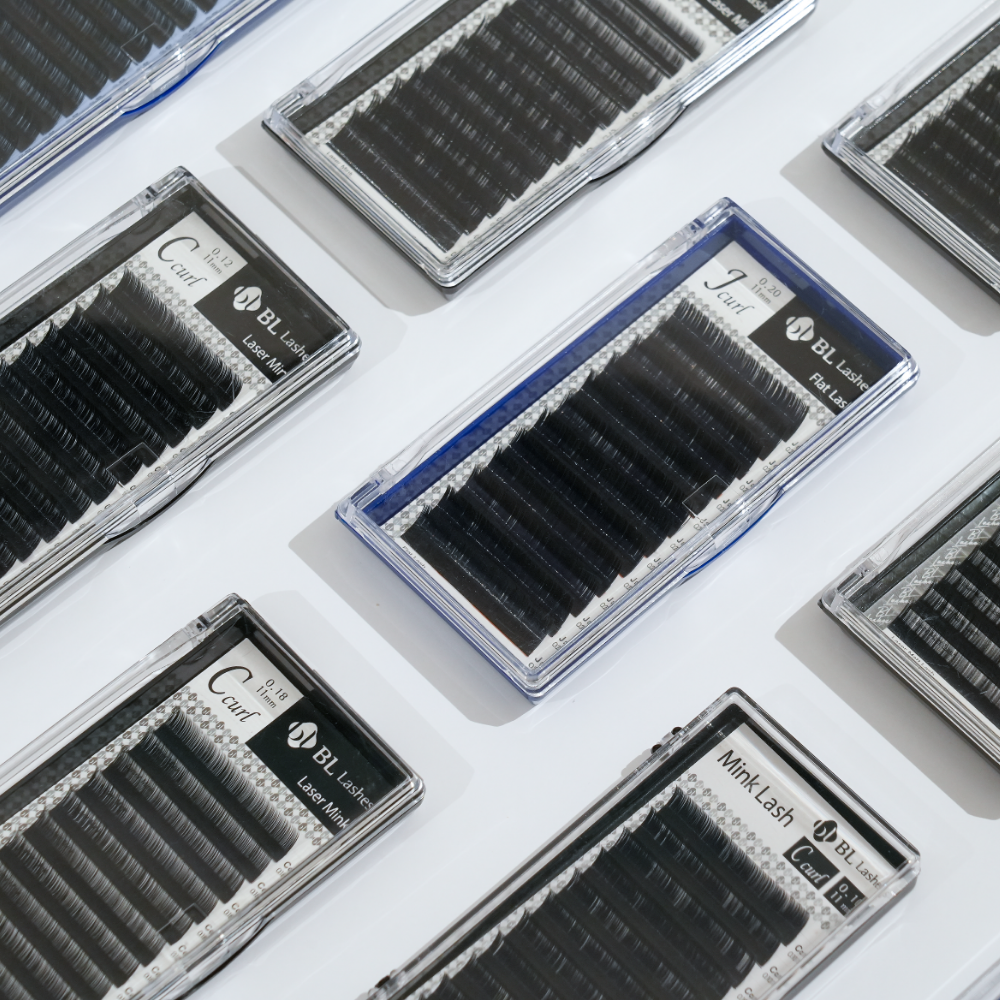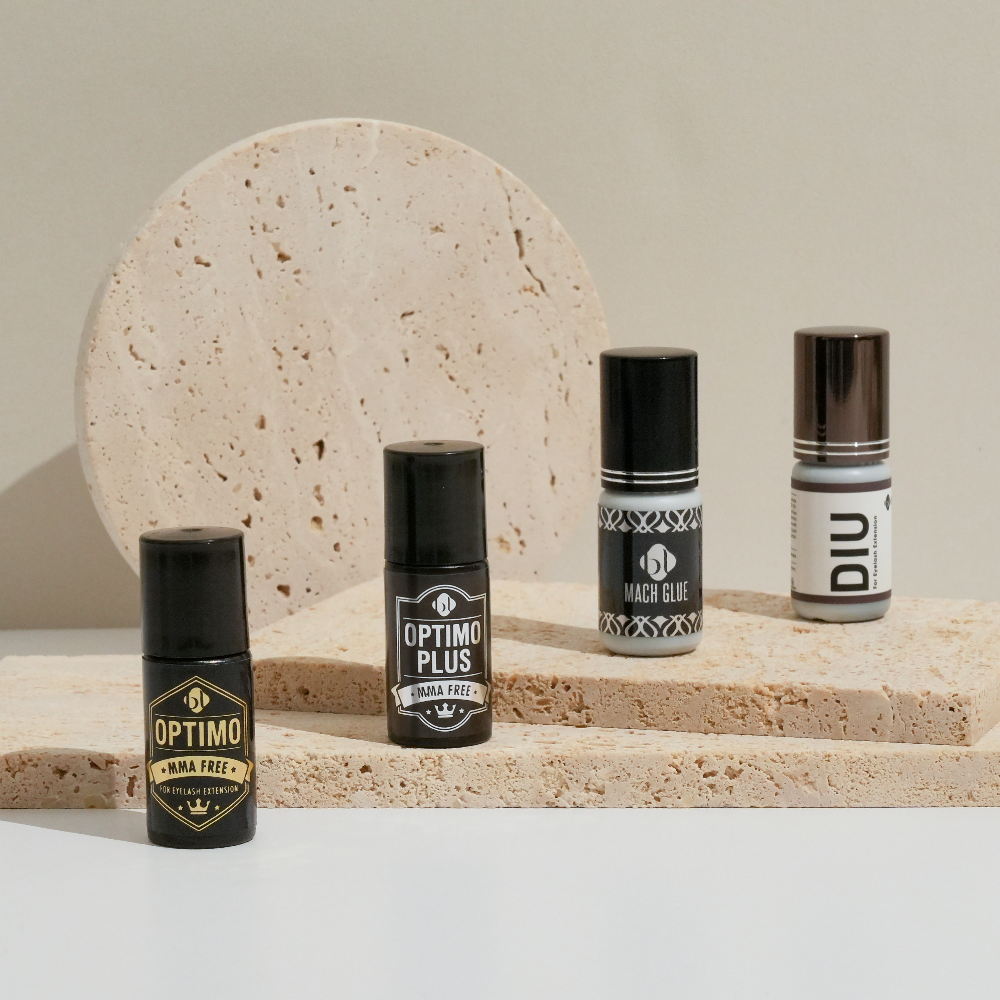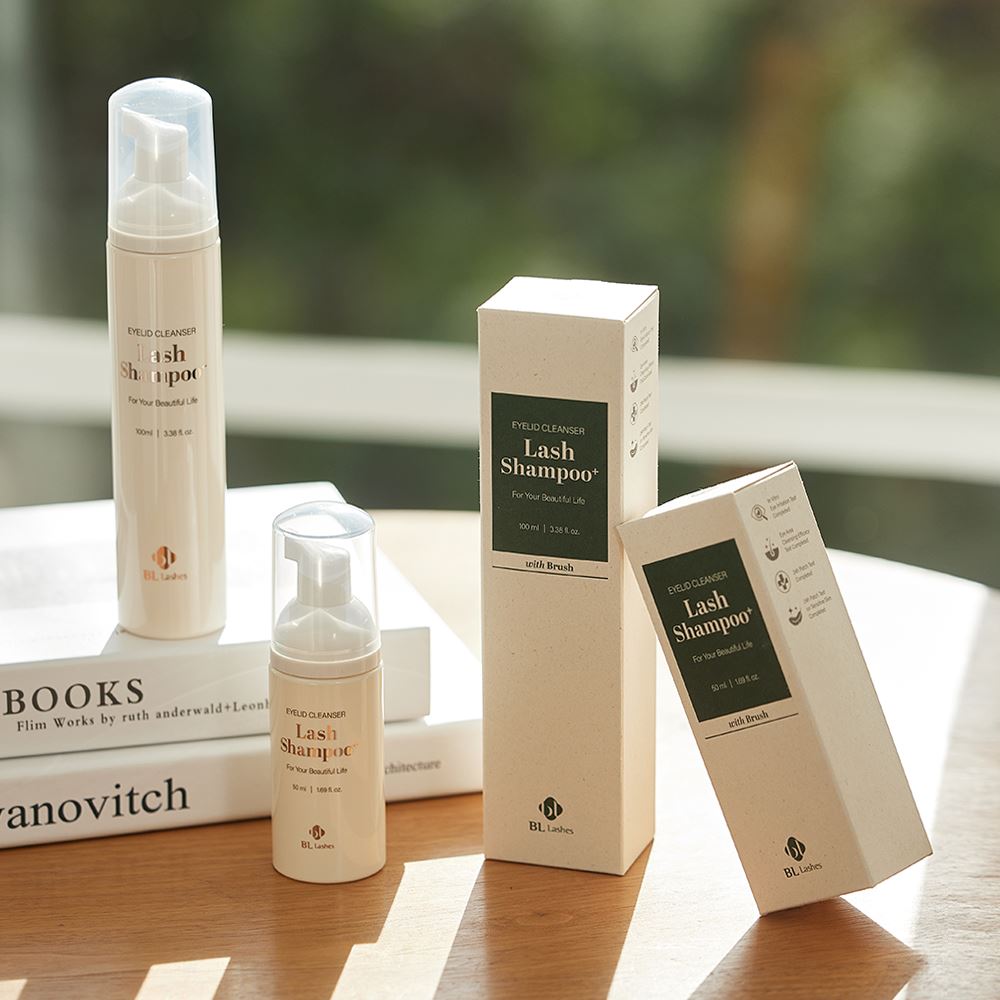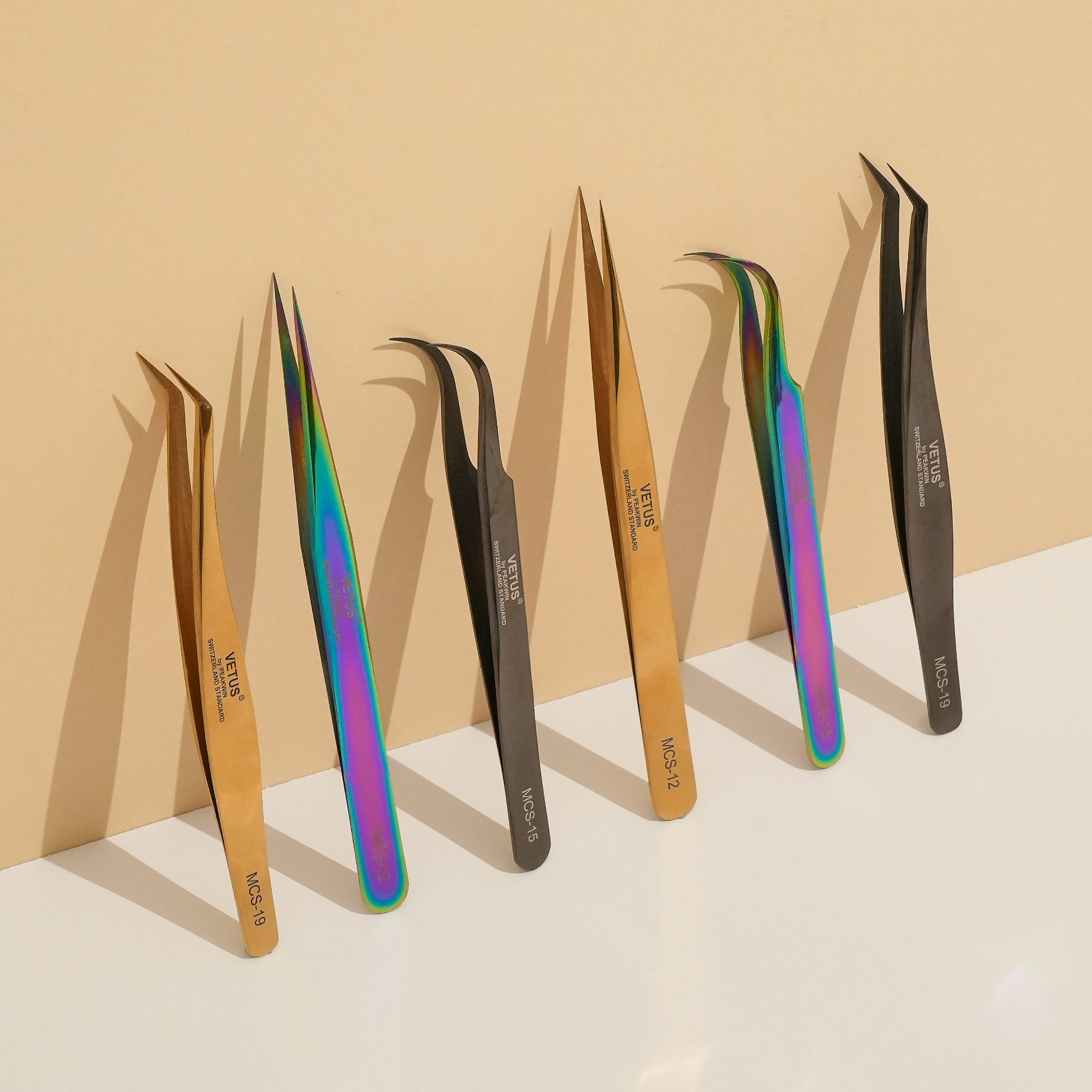Q & A: Everything About Lash Extension Glues

Q & A: Everything About Eyelash Extension Adhesives
1. What is eyelash extension adhesive made of?
The main ingredient of eyelash extension glue/ adhesive is Cyanoacrylate.
Molecules of cyanoacrylate are typically dispersed in a liquid phase. However, when they get in contact with moisture, the molecules combine instantly, and that causes a polymerization process, becoming macromolecules which become the form of eyelash extension glue we know of.
Therefore, the science behind the cyanoacrylate makes eyelash extension glue to have a unique character: it only cures under certain conditions - which is humidity.
2. What are the components of lash extension glue?
Typical components of Eyelash Extension Glue are as the following:
- 90~95% (Cyanoacrylate)
- 5~10% (Complex compounds such as stabilizer, thickener, hardening accelerator, colorant, etc.)
Principles of Hardening Eyelash Extension Glue
Step 1
The stabilizer in the glue prevents adhesive molecules from combining.
Step 2
When we the adhesive to the air, the stabilizer combines with moisture on the surface of the object.
Step 3
The adhesive molecules that have been prevented themselves from combining because of the Stabilizer, polymerizes and then forms a polymer, then start the hardening process.
3. What happens if I use extension glue without shaking?
Eyelash extension glue contains not only cyanoacrylate that is for adhesion, but also other complex compounds such as stabilizer, thickener, hardening accelerator, pigments, and so on.
Then, there will be a separation of layers caused by a difference in the density of each component.
It is necessary to shake the glue to mix all the ingredients properly and ensure the optimum performance and retention of the adhesive.
4. Why does the color of my glue look cloudy?
If you don't shake the extension glue enough, the color of the glue might look like it's faded and cloudy.
If you see a layer separation even though you have shaken it sufficiently more than 1 minute, it can be a manufacturing problem that can happen once in a while. If that happens, contact the customer service with the LOT number (usually written on the bottom of the products).
5. Different types of Cyanoacrylate

Methyl-Cyanoacrylate:
Methyl type is a toxic substance. Therefore, it is strictly classified and used even for industrial purposes. Methyl type can dissolve the proteins and lead to permanent blindness.
Ethyl-Cyanoacrylate:
Ethyl is one of the typical components of eyelash extension glue. Its drying time is fast, and the adhesion is strong, but the odor and irritation are quite strong. It is widely used for industrial, medical, and general household use.
Alkoxy-Cyanoacrylate:
Alkoxy is eight times more expensive than the Ethyl type. It is developed as a hypoallergenic and low odor type product.
Butyl-Cyanoacrylate:
Butyl is an instant adhesive that provides hypoallergenic features and low odor aimed at the use of medical and veterinary.
Compared to Ethyl, its drying time is slower, and the adhesion is weaker. It is mostly used for medical adhesive or thickener in cosmetics.
Butyl type has excellent adhesion but hardens after drying. Octyl type will be softer(tension) after drying. (N-Butyl2, 2-octyl, Isobutyl, etc.)
Methoxy-Cyanoacrylate:
Methoxy is the least irritating and odorless among all the Cyanoacrylates.
It is developed to improve the problems caused by the irritation and odor of Ethyl and Butyl type glue. Its drying time is slower, and the adhesion is weaker, compared to Ethyl and Butyl type glue.
6. Is there any eyelash extension adhesive that doesn't contain Cyanoacrylate?
All types of eyelash extension glues use Cyanoacrylate, which is the only one-component that can be hardened under the circumstance genuinely.
There is no other substitute glue that can replace the retention and adhesion of current eyelash extension glue.
7. Which factors affect the performance of eyelash extension glue?
- Humidity
- Temperature
- Applied amount
- The surface condition of the bonded area
- Level of chemical contamination in the tools or the lashroom
- Client's lash condition
- Light intensity and wavelengths
- and so on.
8. Should the oil removal and primer be done before the lash extension application?
Primer is a significant product and must be used before the extension, as it helps to bind molecules.
If you apply extension lashes on your natural lashes without removing oil or contamination (cosmetic residue, external pollution), extension lashes will combine with those oil or contamination instead of sticking to natural lashes. Therefore, adhesion and retention will dramatically decrease.
In countries or seasons that are very hot, the skin tends to release more oil, and the oil on lashes needs to be removed more thoroughly. If you have a client who has oily or damaged eyelashes, wash and prime her lashes 2 or 3 times, as those eyelashes tend not to be wiped easily.
Learn more about how Lash Primer can help your lash extension, check out this useful post: The Answer to a Long-Lasting Lash Extension: Lash Primer
9. What causes adhesion and retention to decrease?
- Due to Materials: Compatibility of extension lashes and glue, deterioration of glue performance, Inappropriate storage method, and use of products.
- Due to Technician: Incorrect attachment, Incorrect amount of glue, inexperienced use of pre-application treatment.
- Due to Client: Inexperienced aftercare, Conditions of natural eyelashes, Health conditions.
- Due to the Environment: High temperature and high humidity, cold and dry environment, rapid temperature difference, procedures in a non-ventilated place.
Also, several factors are affecting the retention of eyelash extensions, including the technique of lash technician. If you have problems with the retention of unusual eyelash extensions, it is recommended to check these factors.
10. What are the best ways to improve retention?
Many factors can affect retention. (Refer to number 10, Causes of the adhesion and retention decrease).
Among those factors, there are two significant ways to improve retention.
1. Adjust the amount of glue and then attach the lashes correctly with the accurate technique.
2. Secondly, the appropriate use of care products. By removing the oil on the eyelashes before the procedure and using coating agents after the procedure, it can help improve the retention.
Techniques are the most critical part, but it is also vital to know the correct directions of care products and use them accordingly.
11. What is the appropriate temperature and humidity when using glue?
The adhesion and components of glue do not change from -50 to +60 degrees Celsius. However, it is recommended to maintain 22 to 26 degrees Celsius for uniform viscosity and drying time.
If the temperature is high, the viscosity of glue gets thinner, and the drying time is shorter. If the temperature is low, the viscosity of glue gets thicker, and the drying time is longer.
As the eyelash extension glue reacts and dries with humidity, the drying time is closely related to the humidity. For all eyelash extension glues, Its recommended appropriate humidity is 45 to 60%. Therefore, uniform drying time is maintained when the uniform humidity is maintained (Range of 40~70%).
The higher the humidity, the shorter the drying time and time of use after the discharge. On the contrary, the lower the humidity, the longer the drying time and time of use after the discharge. However, if the humidity is over 70%, the drying time of glue will be slower again.
Let me give you an example. BL's DIU glue has 2 to 3 seconds of drying time. If the humidity is 45%, its drying time is 3 seconds, and if the humidity is 60%, the drying time is 2 seconds.
Even if the humidity exceeds 60%, the drying time will not be faster than 2 seconds. Instead, the drying time will be maintained at the speed of 2 seconds for a while, and then it will gradually slow down after 70% of humidity.
If you are aware of the glue hardening reaction depending on the humidity, you can perform a uniform procedure under any environmental conditions.
12. Is there any glue that does not get affected or is less affected by the temperature or humidity?
No glue is not affected by humidity, since cyanoacrylate, a component reacts with moisture and dries, is the main component of the adhesive.
Whereas temperatures affect the viscosity of the glue, so it has less influence than the humidity.
Of all the BL glues, Ultra Plus, Ulbon, and Q-1 glue are the least affected glues from damages from the oil, moisture, and external environment.
13. Which adhesive is suitable for hot and humid weather?
Whichever glue you use, it is essential to adjust the optimal temperature and humidity. Use an air conditioning system or a fan to lower the temperature.
Also, equip a dehumidifier or desiccant and regularly ventilate so that you can reduce the humidity. By doing so, you can adjust the temperature and humidity.
Finally, choose the glue according to your preference after that.
However, in hot and humid areas or weather, excess amount of oil is secreted on the skin and eyelashes. Therefore, it is recommended to use a glue that is more resistant to water and oil.
Also, before the procedure, remember to remove the oil from the eyelashes thoroughly. If the oil tends not to be removed clearly, the natural eyelashes may get damaged. Thus, it is important to remove it 2 to 3 times before the lash application procedure.
Humidity tends to be high in hot countries and seasons. Also, the viscosity tends to get thinner due to the high temperature. Therefore, it is recommended to use a glue that has a bit of viscosity rather than the low viscosity one.
- Recommended glue: DIU (2~3seconds/experts), Q-1 (4~5seconds/intermediates & beginners)
- Water and oil resistant glue: Q-1 (4~5seconds)

14. Which lash extension glue is suitable for cold and dry weather?
Whichever glue you use, it is important to adjust the optimal temperature and humidity.
By using a heater, you can increase the temperature. Also, use a humidifier to adjust the temperature and humidity. Then, choose the glue according to your preference.
If you still have difficulty in increasing the humidity even with the above efforts, you can have the uniform treatment by choosing a lower viscosity glue or faster drying glue.
Below 0 Celsius degrees, be aware that the impact strength of glue is deteriorated. However, if it is maintained at the room temperature after heating or cooling for a short amount of time, there won't be any change of qualities of the substances.
Humidity tends to be low in cold countries and seasons. Also, the viscosity tends to get thicker due to the low temperature. Therefore, it is not recommended to use a glue that has high viscosity. Otherwise, you can choose a glue according to the procedure speed.
- Recommended glue : MACH (1~2seconds/experts), Ultra X, Ultra +(plus) (3~4seconds/intermediates), Ultra Bonding, Ulbon (4~5seconds/beginners)
**If you do not prefer a low viscosity glue, you can use DIU, Fina, or Q-1 as the viscosity of them is higher than the recommended glues.
15. Which are the best eyelash extension adhesives from BL's collection?
It is impossible to compete for the superiority of the glue. It is subject to the treatment environment, proficiency of the technicians, and so on.
Decide the best glue for you by considering the room environment, speed of the procedure, and client type.
For example, if the technicians use 1~2 seconds of drying glue when they take 3~4 seconds to apply extension lashes on natural lashes, the retention will inevitably decrease because the extension lashes are applied to natural lashes after the glue is already a bit dried.
Another example would be as follows; If the technicians use the slow drying glue when their speed of procedure is faster than that, it is not an appropriate glue as well because it will interfere with the procedure.
Also, adjust the procedure environment if the technician is living in a country where there are big changes in weather or humidity and temperature. If it is hard to do so, we recommend using a glue that is suitable for the situation to keep consistent retention and procedure.

16. Recommendations of glues according to proficiency
Based on the classic extensions under the circumstance of appropriate temperature (22~26 Celsius degrees) and appropriate humidity (45~60%)
- Experts: MACH, DIU
- Intermediates: Ultra X, Ultra +(plus), Fina
- Beginners: Q-1, Mild, EZ++, Ultra Bonding, Ulbon
*The above-recommended glues are the guideline according to the drying time, and they are not absolute.
Choose your glue according to:
- the movement of the technician,
- procedure environment,
- characteristics of the clients,
- preferences of the technician, and so on.
17. Which glues are best for volume extensions?
Volume extension glues belong to two main categories: handmade volume glue and pre-made volume glue.
For handmade volume lashes, as you need to make a fan, it is recommended to use a fast-drying glue or the one that has a bit high viscosity. MACH glue is suitable for those who are fast when applying extension lashes. Glam glue is ideal for those who want an adhesive that has longer drying time and thicker consistency.
For pre-made volume lashes, we recommend using a glue that has fast drying time and low viscosity. That is because the adhesion parts of pre-made volume lashes are wide, and adhesive can be applied excessively on those wide areas, which will result in surrounded lashes sticking to them.
MACH glue is suitable for those who are fast when applying extension lashes. Ultra X or Ultra Plus glue is ideal for those who want an adhesive that has longer drying time.

18. Which are fast-drying, but hypoallergenic adhesive?
Currently, it is hard to make a quick-drying glue with the hypoallergenic and low odor cyanoacrylate base.
Although hardening speed can be increased by adding a hardening accelerator called 'Toluene,' it is not used in BL Lashes because Toluene is harmful to the human body.
To find the best lash extension glue for the clients with glue sensitivity, read this post: The Best Lash Extension Adhesive for Sensitive Eyes
19. Are there any waterproof or oil-proof glues?
The instant glue becomes a solid acrylic like plastic after hardening. The surface might withstand a certain amount of water, but the sealing effect of the bonded area itself is not very good. Thus, it is hard to call it a waterproof or oil proof.
Eyelashes do not fall off immediately when they come into contact with water or oil. However, the strength of the adhesion drops dramatically due to hydrolysis.
2 to 20 seconds after the extensions, the hardening progresses more than 93 to 97%. Hence, it has little possibility of forming efflorescence once they are dried 1 to 2 minutes with the fan.
However, the possibility of developing efflorescence increases when the amount of glue is excessive as the hardening takes more time.
It takes about 24 to 48 hours for glues to be dried completely. Therefore, we advise applying a serum or coating sealants after 24 to 48 hours from the extensions.
20. Glue selection according to the eyelash shapes
You can choose various types of glues according to the kind of hair, depending on whether it is damaged or it has different forms of hair follicles.
For customers with curly eyelashes, using a low viscosity glue will decrease the retention of the extensions. In this case, it is better to use an adhesive that has high viscosity.
21. How long is the expiration time (Shelf-life) of the lash glues?
3 to 6 months when not opened, one month once opened.
When the glue is contained in its bottle, it is hard to harden. The surface area that is in contact with the air is small compared to the capacity of the liquid.
However, once it is applied to the material, as the surface area becomes wider, the hardening reaction becomes active, and the whole area hardens in sequence.
Since the hardening of glue is always in progress, its function is kept on deteriorating even if the container not opened yet. The period from the moment it is manufactured to the state of unavailability is called the 'expiration date.'
It is vital to keep the appropriate temperature and humidity and pay attention to the storage methods to prolong the expiration date.
22. Storage methods of the glue
Eyelash extension glue is a reactive type adhesive. Therefore, it is crucial to managing the environment in the treatment room and the storage area.
The glue will not deteriorate at temperatures within -50 to 60 degrees Celsius. Hence, store it where it is cool and dark, avoid the direct sunlight and high humidity instead of storing it in the refrigerator.
When storing it, the deterioration of the glue depends on the humidity rather than the temperature. Therefore, as long as the humidity is low, it can be stored in a place where the temperature is high. However, be aware that, in most of the high-temperature areas, humidity is high as well.
BL Lashes glue has a desiccant in the zip-lock bag together, to prevent the performance deterioration of it, which is caused by moisture. When storing the glue, put the glue container with the desiccant together as it was manufactured and store it upright with the zipper sealed.
To manage the glue effectively, write down the purchase date and opening date on a glue zip-lock bag.
Read this post: How to Properly Care for Lash Extension Adhesive for the in-depth tips and how to's.
23. Is there a way to use the lashing glue for a longer time?
To use the lash extension glue for a long time, pay attention to the precautions and storage methods.
- When discharging the adhesive, lift the outlet from the surface slightly as the dust or dirt may be sucked in the container.
- Wipe the glue nozzle with a piece of paper immediately after use.
- Close the lid tightly and seal it instead of just placing a cover on it to prevent the contact with moisture.
- As it was manufactured, store the glue in a sealed zip-lock bag with the desiccant.
- Store it in a dry and cool place, avoid the direct sunlight.
- In humid season or environment, you can purchase extra desiccants in the glue zip-lock bag. By doing so, you can prolong the expiration date.

24. Do the storage methods depend on the type of glue?
All eyelash extension glues are cyanoacrylate-based adhesives. Therefore, the storage method is the same.
25. Can eyelash adhesive supplies be stored in a refrigerator?
The glue hardens by the reaction with moisture in the air. The most stable storage place is in the dark and cool place.
A refrigerator is not an appropriate storage place as it can affect the performance of glue adversely by causing a dew condensation, not only on the outside but also on the inside.
However, we don't recommend it as it keeps and supplies the moisture nowadays. If you must use the refrigerator inevitably, seal it as much as possible when storing and put it on the room temperature at least 2 hours before use.
26. Is there any alternative for a refrigerator (as a lash glue storage)?
If the temperature of the glue storage place is below 60 degrees Celsius, you should use a dehumidifying box. It has a function of dehumidification. The lower the humidity, the longer the glue will stay fresh.
Directions and precautions:
- Shake side to side, more than 20 times before use, to eliminate the precipitation.
- Discharge a new droplet of the glue every 20 minutes.
- Put the glue with the desiccant in a zip-lock bag and store them vertically.
- It is hard to be hardened in a cold environment. Thus, it is better to use a glue plate. (Use from the middle part because it hardens from the outer part)
- During the procedure, adjust the amount of glue so that it doesn't flow through eyelashes and contact with the mucous membrane.
- Sensitive customers might experience glue side effects. Therefore, proceed with the extensions with sufficient counseling.
- For short-term allergy tests, either apply a small amount of glue on the back of the ear or extend 5 to 6 strands and check the progress 20 to 30 minutes later. For long-term allergy tests, check the above progress 24 hours later.
- As the glue is contained in a particular container(PE material bottle), do not transfer contents to an ordinary plastic or glass container.
- When storing it in a refrigerator, put it on the room temperature at least 2 hours before use.
27. Glue container
You cannot affix some materials with instant glue, such as Silicone, Urethane, PE, PPE, Teflon, and so on. Among them, PE is the most commonly used for the glue container.
The materials and the shapes of the container are critical as the instant glue rapidly reacts with the traces of moisture in the air.
Generally, PE is not used solely. Instead, it is made of laminated structure with Nylon. Since eyelash extension glue is manufactured using a special container like this, please do not transfer the contents to an ordinary plastic or glass container.
28. Can you make glue bottles that are not exposed to air and humidity so it can last longer?
Eyelash extension glue might expand and explode if it is contained in a hermetically sealed bottle.
Therefore, it is impossible to contain the adhesive in such containers. Hence, do not transfer the contents to an ordinary plastic or glass container, as eyelash extension glue is manufactured with the special PE material container.
29. Reasons why the viscosity increases over time.
Cyanoacrylate reacts with the traces of moisture in the air or on the adhesive surface and then hardens instantly.
When it is contained in its container, it is difficult to harden. The surface area that is in contact with the air is small compared to the capacity of the liquid. However, once it is applied to the material, as the surface area becomes wider, the hardening reaction becomes active, and the whole area hardens in sequence.
If the glue becomes stickier than usual, stretches like a thread, or the hardening takes longer than before, then the performance is already deteriorating. Therefore, it is better to discard the glue even if there are some contents remained.
Since the hardening of glue is always in progress, its function is kept on also deteriorating if it is not opened and used. The period from the moment it is manufactured to the state of unavailability is called the 'lifetime(expiration date).'
It is essential to keep the appropriate temperature and humidity and pay attention to the storage methods to prolong the lifetime(expiration date).
30. Clogged outlet
The clogging of the discharge port is caused by gas or bubbles in the adhesive. That gas is generated in the container when discharging.
And then, the bubbles rise with glue and form a layer at the entrance of the outlet. If the glue layer is visible at the opening of the outlet once opened, the layer must be removed by discharging it.
This way, it prevents the outlet from clogging, but it also keeps the glue fresh for a long time by removing the glue layer that is exposed to the air.
It can even happen when the glue bottle is kept on its side or when it is shaken vertically instead of side to side. In this case, use a glue pin that is contained with glue to pierce the clogged hole.
31. What is Efflorescence?
This happens when *the particles are absorbed in the adhesive area. (*Monomers of small molecular weight, such as methyl or ethyl cyanoacrylate, are vaporized in the air and polymerized into short polymers. These are incompletely grown by moisture in the air.)
-> This is used for fingerprinting.
It happens when the glue comes into contact with the pre-treatment that has not dried during the procedure. Or even with the customer's tears when the glue has not dried yet. It can also happen when the serums or coating sealants are used right after the extensions while the glue is not dried completely.
2 to 20 seconds after the extensions, the hardening progresses more than 93 to 97%. Hence, it has little possibility of forming Efflorescence once they are dried 1 to 2 minutes with the fan. However, the chance of developing efflorescence increases when the amount of glue is excessive as the hardening takes more time.
Usually, the glue dries(hardens) altogether 24 to 48 hours later. Therefore, avoid using coating sealants and serums for two days after the extensions.
32. There are white molds in the glue container
Molds and germs cannot reproduce in glue.
It is the polymer (Efflorescence) that is seen as a white powder in the container.
Eyelash extension glue might expand and explode if it is contained in a hermetically sealed container. Therefore, it is impossible to keep it in such containers.
Hence, do not transfer the contents to an ordinary plastic or glass container, as eyelash extension glue is manufactured with the specific kind of container.
As the glue might expand and explode if it is contained in a hermetically sealed container, it is contained in a special container to allow a small amount of air to pass through. Therefore, even if you close the lid tightly, the glue is likely to deteriorate after 3 to 6 months.
The adhesive hardens and generates gas when it comes in contact with moisture. And at this time, the traces of glue are mixed in the gas.
Glue tends to settle on moisture and oil. The particles are absorbed on the moisture and oil in the glue container (handheld part), making them look white. -> This is used for fingerprinting.
33. Irritations (Sore eyes, bloodshot eyes, runny nose, etc.)
As the glue hardens, it generates gas. And at this time, the traces of glue are mixed in the gas. Eyelash extension adhesive tends to settle on the moisture, and that irritates the eyes. As a result, it causes sore eyes because there are tears on the surface of the eyes.
Some technicians wipe the glue onto the eye patches during the procedure, to adjust the amount of glue. This should be avoided as it can irritate the eyes more because the glue hardens on the surface of eye patches.
If the customer tears during the procedure, there is a high possibility that their eyes are not closed completely. Therefore, dry those tears with a fan and proceed with the extensions after checking their eyes thoroughly.
If they still have problems with irritation, it is better to use hypoallergenic glue.
Find out what's the best lash extension glue for glue-sensitive clients
Technicians can also reduce the irritation by wearing a goggle and mask. Additionally, if you put BL's anti-allergy gel right next to the glue, you can reduce the irritation more dramatically.

34. Is eyelash extension glue harmful to the human body?
Although there may be short-term sore eyes and bloodshot eyes due to glue irritation, cyanoacrylate is not toxic, unlike ordinary cyanide materials.
It is not accumulated in the body and wholly decomposed and discharged out of the body in about two months. As a result, it is used as a medical adhesive.
35. I have a hordeolum (sty) in my eye.
A sty is caused by infections of the lachrymal glands and auxiliary glands of the eyelids, mainly by staphylococci. Since the germs cannot reproduce in the glue, it is not caused by the glue itself.
As it is an infectious inflammation, it is more likely to be caused by unsanitary hands, or contaminated treatment environment (tools, subsidiary materials) rather than troubles result from the glue.
Always make sure to disinfect your hands and tools before the procedure and pay attention to keep dust from accumulating on subsidiary materials such as extension lashes and tapes. Also, do not touch the extension lashes and glue plate with your hands.
You might find this post useful: How to Sanitize your Lash Extension Tools
36. I have itchy eyes, and they are irritating
If the extension lashes are extended to multiple strands of natural eyelashes instead of a single strand or attached with the downy hair, it may feel irritated or itchy. It is essential to check the lashes after the extensions, to see if there are any attached eyelashes beside.
Your eyes may also feel irritated when it is attached to the mucous membranes instead of away from the skin, or the lump is on the lashes due to the excessive amount of glue.
Read this post to learn How to differentiate 'glue allergy' and 'eye irritation.'
Otherwise, it can be caused when the treatment environment is not clean, or the customer is immunocompromised due to the bad condition.
Therefore, always keep the treatment environment clean and check the customer's condition.


